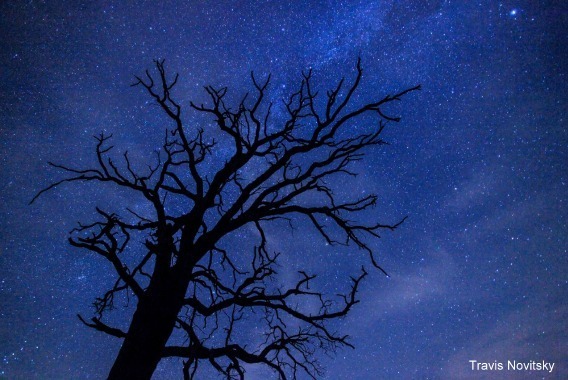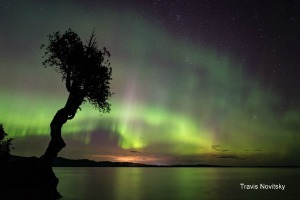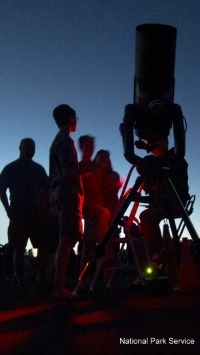Traveler - What's Up?
Minnesota State Parks and Trails
Traveler
August 2017

Buffalo River State Park
Take some time this month to look up at the night sky and enjoy the dazzling display of stars and planets. Buffalo River State Park, located 14 miles from the large metropolitan area of Fargo-Moorhead, offers visitors incredible views of the night sky, unobscured by light pollution. When daylight comes, you can also experience the vastness of the once great prairie that covered the western portion of the state. Throughout the year, 200-plus species of birds can be observed in the area. For an unforgettable experience, reserve a seat in a blind and get up before sunrise to see the local prairie chickens perform their annual mating dance in March and April. Paved paths attract many visitors to the wheelchair-accessible swimming pond with a life guard on duty through August 20.
- Find maps, directions and other park information about Buffalo River State Park.
- See the beautiful sights of the park with this snapshot tour.
The List - Telescope Observing at State Parks
You can learn about the night sky by attending a program at a Minnesota state park. Universe in the Park is a summer outreach program hosted by the University of Minnesota - Minnesota Institute for Astrophysics and area state and local parks. At these events, representatives of the Institute present a short (20- to 30-minute) public talk and slide show. Afterward, if weather allows, attendees have the opportunity to view the sky through multiple 8-inch reflecting telescopes.
Several state parks offer these opportunities, including:
- Mille Lacs Kathio State Park - 8:30-10 p.m. Friday, Aug. 4
- Father Hennepin State Park - 8:30-10 p.m. Saturday, Aug. 5
- William O'Brien State Park - 8:30-10 p.m. Friday, Aug. 11
- Lake Maria State Park - 8:30-10 p.m. Saturday, Aug. 12
Find out more about the Universe in the Park series.
Discover - Night Sky PhenomenaThere's a lot going on in the skies above us, but many people don't pay attention to what's happening beyond our planet. One unique celestial event will occur this summer and then not again until 2099. On August 21, we have the rare opportunity to witness the great North American solar eclipse. People across the U.S. will be able to see a partial-to-total eclipse of the sun! Most Minnesotans will witness 80% of the eclipse. In honor of this rare phenomenon, several solar eclipse parties will take place, including events at Afton, Itasca and Tettegouche state parks. If you aren't able to make it outside to observe the solar eclipse, you will have several opportunities throughout the year to observe the northern lights, another natural phenomenon that can be truly awe inspiring. Various parks offer northern lights programs including the Nature's Nightlight: Northern Lights program scheduled for 3 p.m. Saturday, August 19, at Scenic State Park . |

|
Find out more about the northern lights and where to view them in Minnesota.
Game Time - Counting Meteors
You can experience meteor whiplash every August during the Perseid Meteor shower. This astronomical event provides an annual opportunity to count meteors as they collide with the Earth's atmosphere and burst into flames. At peak, you might see 150-200 meteors in an hour.
The meteor shower will peak around 3 p.m. Saturday, Aug. 12, which means that the night before and the night after will both have good rates.
Find a location that provides open views of the night sky away from city lights. Go to a dark area, in the suburbs or countryside, and prepare to sit outside for a few hours. It takes about 30 minutes for your eyes to adjust to the dark, and the longer you wait outside, the more you'll see. A rate of 150 meteors per hour, for instance, means two to three meteors per minute, including faint streaks along with bright, fireball-generating ones.
Go out on your own to observe this exciting event or attend a program at one of the many state parks offering Perseid parties on the evening of August 12: Whitewater, William O'Brien, Upper Sioux Agency and Zippel Bay state parks.
Check out Minnesota Starwatch to learn more about the Perseid meteor shower and other astronomical happenings.
Traveler Tip - Star Gazing Tips
Stargazing is easy. A clear night and a star chart are all you need. Binoculars are very useful, as is a spotting scope or other telescope, but there is a lot to see with only the naked eye.
- A flashlight covered with red cellophane, or similar material, gives enough light to see the star chart.
- Don't use a bright light because your eyes have to adjust to the darkness each time the light is turned off—and the eyes take about 15 minutes to really adjust.
- On a moonless night you can see about 2,000 stars with the naked eye. Using binoculars, you can see about 100,000.
- Your stargazing can be helped by visiting a planetarium. There you will be given a guided tour of the stars.
- There are numerous books and several magazines about astronomy, and your librarian will be able to suggest some to match your interests.
- In many places, night sky viewing has become nearly impossible due to light pollution from our cities (see light pollution map, above). You can help minimize the impacts of light pollution by installing shielded fixtures (down lighting), turning unnecessary lights off at night, or using motion sensors.
Learn more about our night sky and its importance as a natural resource.
August Events - Astronomy Programs
|
Find more naturalist programs.
Keep reading! For past issues of the Traveler, click here.




